Scientists suggest that about 2/3 of the world’s population is affected by this or this parasitic disease. Among the various parasites in the human body, the most dangerous parasite will not only cause discomfort to the patient, but also cause dangerous complications and even death. In our article, we will tell you all about parasites, that is, we will describe the most terrifying parasites and list the most dangerous symptoms of helminthiasis.
Various parasites
There are many kinds of worms and protozoa living in the human body:

- Worms. These worms most often live in the intestines, but it is possible that they settle in the liver, brain, lungs, heart, kidneys, muscles and other organs. Worms can cause dangerous diseases and complications.
- Parasitic protozoa and multicellular (protozoan parasites). These pests are common in different latitudes. These protozoan human parasites can infect the intestines, eyes, brain, esophagus, heart, muscles and nerves, liver, skin, and even the genitourinary system. The most common protozoan parasites in the human body are lichens, lambs, toxoplasma gondii, trichomoniasis, blastocysts and so on.
- Other creatures that are also human parasites are lice, bugs, ticks, and fly larvae. Their name is ectoparasites. They can parasitic not only on the surface of the skin, but also in wounds, hair follicles and eyelashes.
- Other parasites are more common species that affect subcutaneous tissues, but can parasite in the urethra and nasopharynx. These are the larvae of flies, mosquitoes, and fleas.
We have listed the main types of parasites in humans. However, if we talk about what types of parasites live in the human body in latitude, the most terrifying of them is:
- Pork tapeworm;
- Wide ribbon;
- worm;
- Chinese fl fortunate;
- round bug;
- Vampire;
- Trichinella;
- Pneumococcal;
- Whipworm
- Dwarf tapeworm;
- Bullish worm;
- Liver fluke;
- Paragonimus;
- Echinococcus.
The diseases they cause
The most dangerous parasites in the human body can cause many diseases. Usually, the disease caused by a particular parasite has the same name. Therefore, various types of parasites in the human body may cause the following diseases:
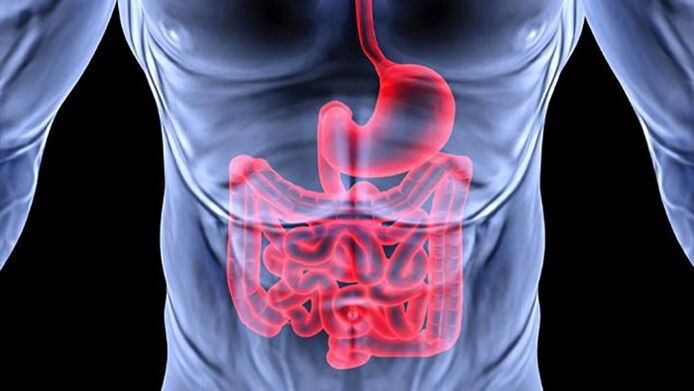 Certain parasites (flukes) in the human body can cause flukes.
When the tapeworm is infected, it happens
Certain parasites (flukes) in the human body can cause flukes.
When the tapeworm is infected, it happensHowever, parasites in the human body can infect multiple organs. According to the position of the parasite in the human body, the following parasitic diseases can be distinguished:
- If the eyes are affected, onchocerciasis, helminthiasis, cysticercosis and myopathy may occur;
- Gastrointestinal diseases caused by single-celled parasites and worms-cworm disease, trichinosis, myotoniasis, small intestinal helminthiasis, enteromyopathy and beetchiasis;
- Brain diseases-hydatidosis, toxoplasmosis, pneumococcal disease and cysticercosis;
- Dermatological diseases-Demodicosis, head lice, scabies, disease, thrombosis, pharyngitis;
- Lung diseases-hydatid disease, ass worm disease, worm disease, pneumococcal disease, toxic toxin, etc. ;
- Liver diseases-aspirin biliary disease, pneumococcal disease, echinococcosis, bronchiectasis;
- In the mouth, ears and mouth, parasites can cause different types of myopathy;
- Heart disease-filariasis and echinococcosis;
- Diseases of the genitourinary system-alveolar disease, urate myopathy, echinococcosis;
- Vascular disease-filariasis and schistosomiasis.
Symptoms
We have already considered what parasites are in the human body. Now, let us look at the main symptoms caused by the simplest human parasites and various worms. It is worth noting that pathogenic worms and protozoan cysts often become the cause of infection. They can stay in the external environment for a long time, waiting for the right moment. When in a good condition of the human internal environment, larvae will emerge from the cyst and actively develop into adults.
When in a good condition of the human internal environment, larvae will emerge from the cyst and actively develop into adults.
In addition, it is worth explaining what a cyst is. In most cases, cysts are the simplest single-celled organisms, bacteria and protists. Protozoan cysts are a temporary form of organisms that exist under adverse conditions. In fact, it is a protective shell. Cyst formation occurs at a certain stage of the parasite's life cycle or under adverse conditions.
c worm disease
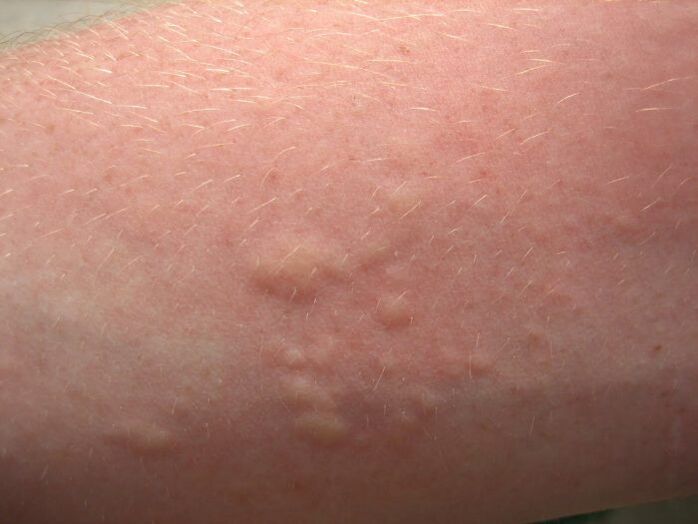
This disease is caused by roundworm. These parasites can only live in the human intestine. The complexity of the symptoms depends on the intensity of the invasion and the age of the patient. The common symptoms of the disease are:
- Itchy allergic rash (such as blisters or hives);
- High fever;
- General discomfort;
- Excessive sweating;
- Weaknesses;
- Enlarged liver;
- in the migration phase: shortness of breath, cough, wheezing in the lungs;
- Loss of appetite;
- Diarrhea and constipation;
- Disgusting; From the side of the central nervous system: irritability, sleep and memory disorders, convulsions, meningitis;
- Liver abscess, obstructive jaundice, appendicitis, pancreatitis and obstruction can develop with a large number of invasions.
Tenahlinholz
This disease causes cattle tapeworm. In the initial stage, the disease is asymptomatic and can last for several years. Sooner or later, the following symptoms will appear:
- The upper abdomen is heavy;
- Nausea, heartburn;
- Increased saliva;
- gagging; Appendicitis, intestinal obstruction, bile duct obstruction;
- Weight loss in the context of increased appetite;
- Vitamin deficiency;
- allergic reaction;
- Dizziness, weakness, sleep disturbance, increased nervousness and irritability;
- Arterial hypertension and tachycardia.

Enteropathy
Worms can cause this disease. This is the most common parasitic disease. The symptoms are as follows:
- Anal itching, worse at night;
- Scratching and redness in the area;
- Suffering from sleep, bruxism, lethargy, drowsiness appears;
- Loss of appetite;
- Infantile abdominal pain, urinary incontinence;
- Unstable stool, nausea, flatulence, vomiting;
- Allergic reaction.
Toxoplasmosis

Toxoplasma worms are parasitic in various human tissues and organs. However, no matter where they are located, they will always cause allergic reactions in the body, and follow the following types:
- A rash similar to mosquito bites. The rash can appear on all parts of the body.
- Bronchial asthma, manifested by a dry, persistent cough and a small amount of sputum.
- Quincke's edema. Swelling of the skin on the face and neck can cause suffocation and even death.
Necromancer (hookworm)
This disease is caused by worms called mosquitoes and hookworms. The invasion is manifested by the following complex symptoms:
- When larvae are introduced through the skin, dermatitis, hives and various rashes may occur. At the site of penetration, there is swelling, itching and burning. The invasion period lasts up to 12 days.
- The migration stage is also accompanied by allergic manifestations. In this case, the respiratory tract is injured, and bronchitis, pneumonia, tracheitis and laryngitis occur. The patient has fever, cough, shortness of breath, and hoarse voice.
- Within a few months, the intestinal phase of the disease begins. At this stage, there are symptoms of iron deficiency anemia and duodenitis. The patient is irritable, fatigue and sleep disturbance increase. Women have irregular menstruation.
Important! In childhood, hookworm infection can cause mental and physical development delays.
Giardiasis
Giardia is a parasitic protozoan disease. A quarter of the population carries this microorganism asymptomatically. In the acute phase, the following signs appear:
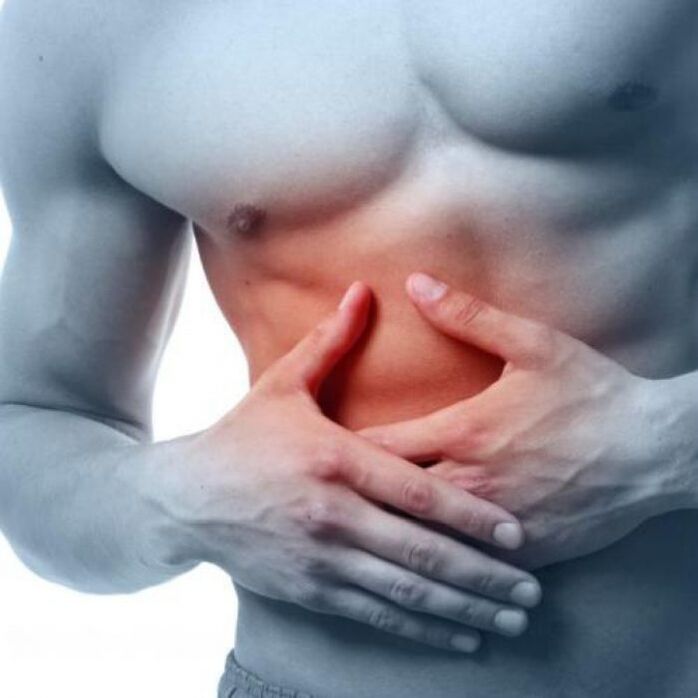
- Abnormal gastrointestinal function;
- The pain in the lower right cartilage and the area around the belly button afflicted the patient.
- Flatulence, decreased appetite, gas, nausea.
- Diarrhea and constipation alternate, and foamy stools may occur frequently (up to 5 times);
- has a subacute course, intestinal symptoms persist, and the patient loses weight;
- has severe infiltrative intoxication and fever;
- Children have itching, urticaria and fainting. A
- co-programmed cyst of protozoa was found in the feces.
Amoebiasis
This disease is caused by histological amoeba. The disease can be asymptomatic or symptomatic. The disease has two forms: parenteral and intestinal. These protozoa can affect the brain, lungs, skin, and genitourinary system. But the most common is intestinal amebiasis. The symptoms are as follows:
- At the beginning of the disease, diarrhea is accompanied by a large amount of foamy stool, followed by a jelly-like stool like raspberry jelly. Their frequency is up to 20 times a day;
- The severe pain is located on the right side of the abdomen.
- Slightly low fever;
- After 6 weeks, the acute course may weaken;
- The examination can show protozoa in the feces.
Important! Amoebiasis never goes away on its own and often recurs. If left untreated, amoeba will form, leading to intestinal obstruction.
Hairy flagellosis
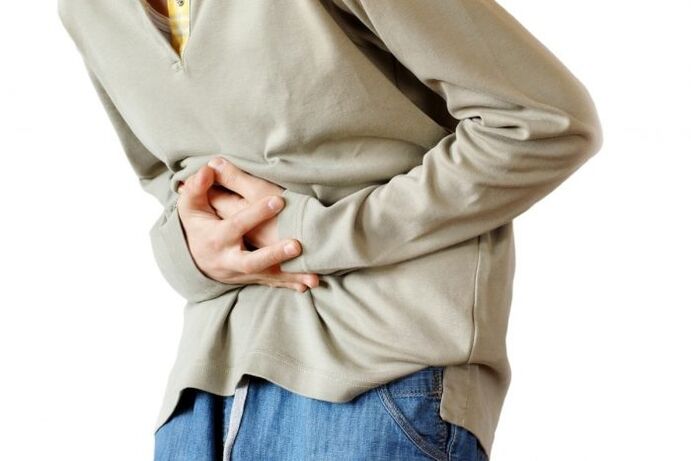
The widespread tapeworm is the culprit of this disease. The representative of the swelling caused the following clinical manifestations of the disease:
Weight loss, irregular bowel movements, decreased appetite;Tendon degeneration
This disease is caused by pork tapeworm. The parasite is located in the small intestine and causes the following symptoms:
Constipation, vomiting, diarrhea, nausea;Hydatid disease
Echinococcus is asymptomatic for a long time. Then there is pain in the area where the hydatid oc capsule is formed. Usually, symptoms are characteristic of tumors in specific organs. When the cyst ruptures, systemic poisoning, anaphylactic shock and urticaria occur.
Types of parasites in the human body
All types of parasites in the human body have adverse effects on their health. They infect organs, feed on nutrients needed for human life, and release harmful toxic substances. Therefore, it is very important to remove them in time.
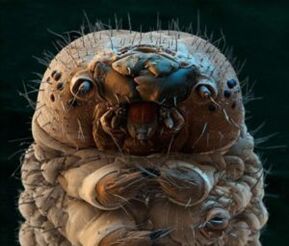
The human body is affected by various parasites. Some parasites live in the body, while others live on its surface. Their size, the way they enter the body, and the characteristics of important functions are all different.
What parasites exist in the human body? How to get rid of them? What are the preventive measures? These issues will be discussed below.
Classification of parasites
Human parasites are very common, divided into several categories:
- Endoparasitesare organisms that parasitize the human body. This group is divided into protozoa (consisting of single cells) and worms (worms). The simplest parasites in the human body are amoeba, lamblia, trichomoniasis, and toxoplasma. As for worms, they are divided into round worms (nematodes), flat worms and division worms.
- Parasitesare organisms that live on the surface of the human body, including lice, lice, fleas, and bed bugs. They not only feed on human blood and cause great discomfort (bites, burns, skin wounds), but also carry quite dangerous diseases: typhus, anthrax, trypanosomiasis, etc.
- Giardia.Giardiasis infection is a fecal-oral mechanism. After removing the cysts (parasites that have not yet formed and covered with a protective film) from the patient's anus, they will spread to vegetables, fruits and other foods. Cysts enter the human mouth through poor hand washing, stagnant water, and inadequately washed fruits and vegetables, and from there safely to the intestines, where they become adults again and multiply. The result is a vicious circle that will continue until adequate treatment is provided and sanitary measures are taken. The symptoms of the disease are weakness, fatigue, headache, diarrhea, abdominal pain and bloating. Anal itching, rash, and bronchial asthma can all occur. The pathological features are weight loss, anemia and weakened immune system. Treatment-Metronidazole, Furazolidone, Tinidazole. The dose is prescribed by the doctor.
- Toxoplasma gondii.These protozoan infections occur through contact with infected pets. In this case, humans are the intermediate host, because the parasite's sexual development cycle occurs in the animal's body. The disease is characterized by a continuous increase in body temperature to sub-fever levels, general signs of poisoning, swollen lymph nodes, and joint and muscle pain. Moreover, the function of the gastrointestinal tract and vision is destroyed, the central nervous system may be damaged, and there are signs of heart disease and endocrine system. Complicated treatments are prescribed-tetracycline antibiotics and sulfa drugs.
- Trichomonas.Trichomonas is sexually transmitted, and the risk of infection caused by contact is small, but it still exists. Symptoms of the disease in women are itching, redness of the genitals, burning sensation and foam discharge. Men may have difficulty urinating and be discharged from the hospital. Treatment-anti-trichomoniasis.
Worm is an intestinal parasite
The most famous internal parasite is the pinworm. They live in the intestines and cause a disease called enteropathy. This type of parasite affects not only humans but also monkeys. People at risk-preschool children. According to statistics, half of children between 2 and 10 years old are diagnosed with bowel disease.
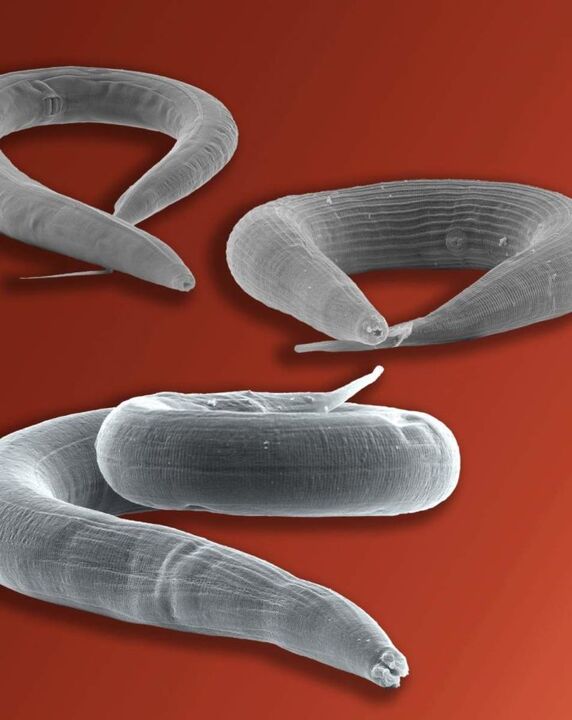
The worm spreads from person to person, and you can infect it through any object used by the sick person or by shaking hands. The main condition for pinworm egg transfer is not to wash hands after contact, especially before eating. Worms, or their eggs, can be carried by flies and cockroaches.
Pinworms can only live in the intestine, and they are particularly comfortable in the thinner part of the colon and cecum. For mating, the parasite chooses the ileum, from where the female crawls out of the anus and lays eggs in the anus. The symptoms of pinworms in the body are anal itching, allergies, fatigue, anemia, abdominal pain, and exhaustion.
Prescribe levamisole, mebendazole, albendazole and other anthelmintics to treat small intestinal helminthiasis. Prevention of insects is based on hand hygiene. It must be washed after visiting any public place.
Worm-worm
An adult can reach 40 cm in length. Round worms live in human intestines. The eggs hatch naturally, and then continue to grow in the soil until they enter the human body again. Dirty hands and unwashed vegetables and fruits are methods of roundworm infection. The worm eggs are covered by a shell that is insoluble in the human stomach and allows the survive worm to survive and enter the intestinal tract developed by the mature individual.
c worm disease has no symptoms for a long time. Symptoms then appear, depending on the location and stage of development of the parasite. During the first migratory stage of assimilation, the patient is worried about fever, cough, cough, rash, migraine, swollen lymph nodes, liver and spleen. In the later stages, when the parasite has entered the intestine, stool disturbances (dysentery, cholera-like symptoms, signs of typhoid fever) are observed. Pain in the abdomen, rapid weight loss and fatigue.
Wide ribbon
This parasite is infected by fish. This is the intermediate host of the worm. It is not necessary to eat for the sake of infection, and sometimes just contact with infected fish is sufficient. This is why you must handle your hands, knives, and plates very carefully after cutting the fish.
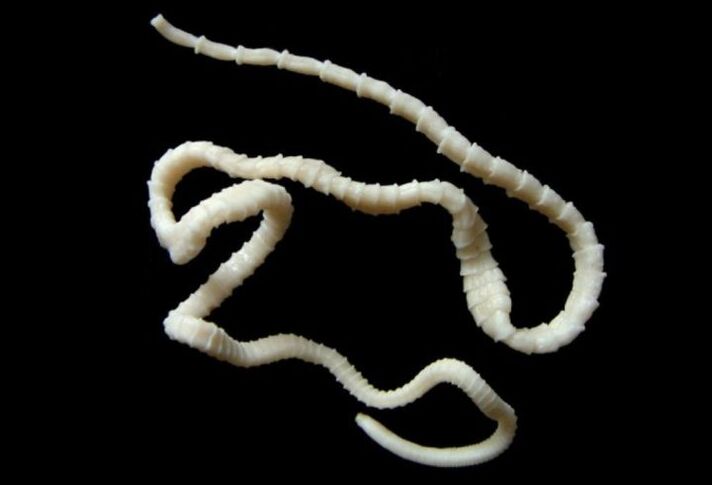
Neither worms nor their larvae will spread from sick people to healthy people. The symptoms of infection are nausea, vomiting, abdominal pain, increased appetite, and indigestion. The first symptoms of the disease may appear one or two months after infection. Due to the long-term existence of this parasite in the human body, the skin is pale, headache, rapid heart rhythm, lowered blood pressure, weakness, and anemia. The purpose of treatment is to kill the worms. For this, please use Praziquantel, Niclofenamide.
Bull tapeworm
Bovine tapeworm can grow up to 12 m, is a hermaphroditic, and can produce more than 100, 000 eggs, which are excreted through feces. The eggs fall into the soil and then into the plants, which are eaten by the cows. In animals, the eggs become larvae and are located in the muscles. If a person eats contaminated beef, the larvae will enter the intestines. The larvae do not spread from person to person.
The head of an adult worm has four suction cups, a neck and a body composed of line segments. The number of segments is increasing, and mature segments can be separated from the worm and crawl out of the human intestine.
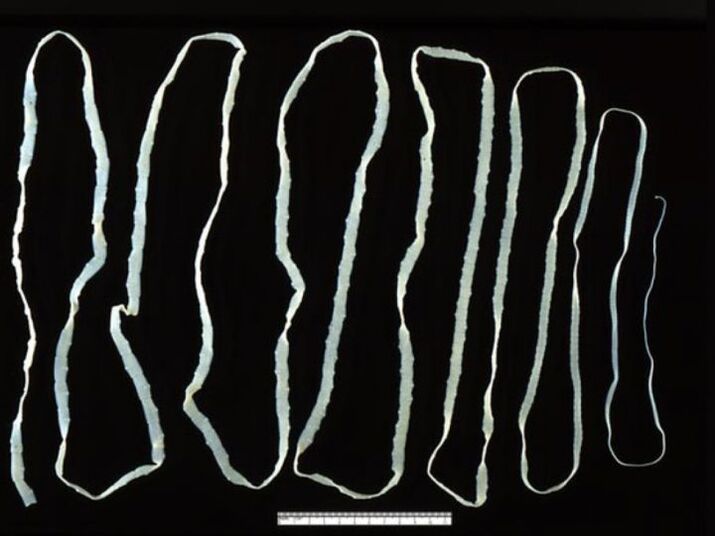 The symptoms of the disease are nausea, vomiting, indigestion, increased salivation, dizziness, weakness, nervousness, fatigue, abdominal pain, uncertain positioning, allergies, and loss of appetite.
The symptoms of the disease are nausea, vomiting, indigestion, increased salivation, dizziness, weakness, nervousness, fatigue, abdominal pain, uncertain positioning, allergies, and loss of appetite.
In order to remove bovine tapeworms from the body, there is a plan that includes three stages: preparation stage (cleansing the body), treatment with antiparasitic drugs (Biltricid, Praziquantel, Niclosamide), and recovery (diet, herbal medicine).
Pork tapeworm
A person can be infected with pork pork worms through unclean hands, cooked meat, or dirty water. Infected people can release tape worm segments and larvae into the environment through vomit and feces.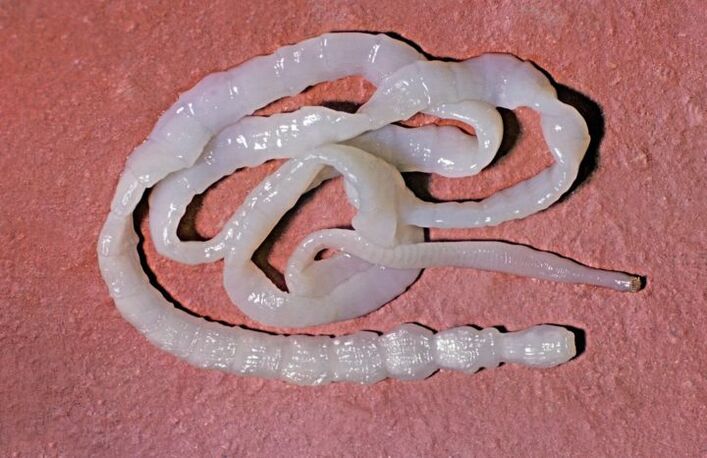 The worm can live in the human body for up to 15-17 years. It adheres to the intestinal mucosa, and its larvae can spread through the bloodstream to the whole body and attach to any organ. It is especially dangerous if the larva enters the brain.
The worm can live in the human body for up to 15-17 years. It adheres to the intestinal mucosa, and its larvae can spread through the bloodstream to the whole body and attach to any organ. It is especially dangerous if the larva enters the brain.
Pigs are an intermediate host; people who are in regular contact with raw meat are most susceptible to this parasite. Touching and eating meat that has not been sufficiently heat-treated can infect the pork chain. In order to destroy all the larvae of the pork tapeworm in the meat, the meat must be cooked or frozen for a long time for 2-3 weeks.
Pork tapeworm can affect the small intestine, liver, brain, visual organs, muscles, etc. If the worm infects vital organs, then a person may become paralyzed or even die.
Pork tapeworm symptoms: allergic reaction, abdominal pain, nausea and vomiting, weakness, dizziness, headache, weight loss, anal itching. Worms infect the intestinal mucosa, so the symptoms are very similar to enteritis.
Treatment involves taking drugs that have a paralyzing effect on the worms, so it cannot stay on the intestinal wall and be excreted. However, at the same time, it emits a large amount of toxic substances, which may cause anaphylactic shock in people. Therefore, treatment can only be carried out under the supervision of a physician.
Parasites in the mouth
Parasites in the population can usually be represented by the following species:
- Trichomonas;
- Mouth amoeba;
- Diptera larvae (oral myopathy).
The clinical picture may be as follows:
- Allergies;
- Weakness, weight loss;
- There is a stench in the mouth;
- The feeling of throat movement;
- Itching and sweat;
- Nausea, loss of energy.
The worms in the mouth can damage the teeth and form purulent deposits on the mucous membranes and tongue. It is prescribed only by a doctor who considers the existing symptoms and the type of parasite. The prerequisite for treatment is to check all people in contact with the patient.
Summary
Above, not all factors have been considered, even the most common parasites that can live in the human body. It is important to understand the great dangers in this community: worms in the human body can cause very serious consequences and ultimately lead to the death of its owner. Therefore, it is very important to diagnose and eliminate parasites in time. As for preventive measures, they mainly include hygiene and high-quality roasting of edible meat.






































